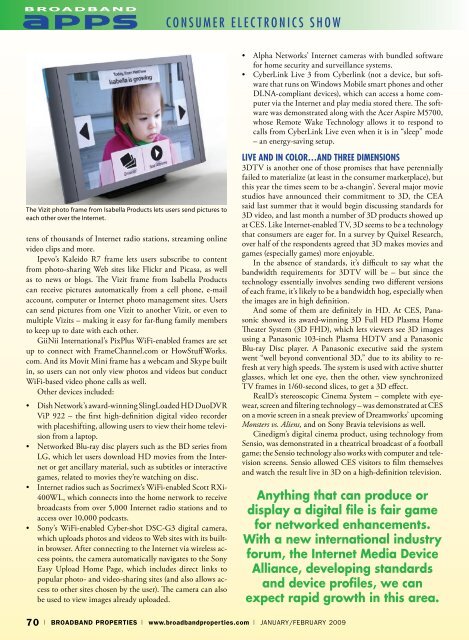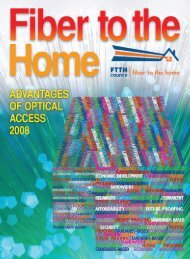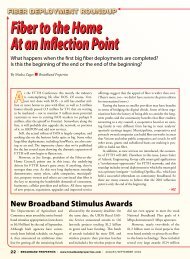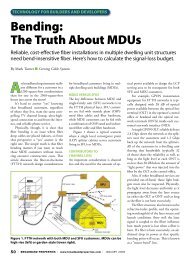bbpmag.com - Broadband Properties
bbpmag.com - Broadband Properties
bbpmag.com - Broadband Properties
Create successful ePaper yourself
Turn your PDF publications into a flip-book with our unique Google optimized e-Paper software.
CONSUMER ELECTRONICS SHOW<br />
• Alpha Networks’ Internet cameras with bundled software<br />
for home security and surveillance systems.<br />
• CyberLink Live 3 from Cyberlink (not a device, but software<br />
that runs on Windows Mobile smart phones and other<br />
DLNA-<strong>com</strong>pliant devices), which can access a home <strong>com</strong>puter<br />
via the Internet and play media stored there. The software<br />
was demonstrated along with the Acer Aspire M5700,<br />
whose Remote Wake Technology allows it to respond to<br />
calls from CyberLink Live even when it is in “sleep” mode<br />
– an energy-saving setup.<br />
The Vizit photo frame from Isabella Products lets users send pictures to<br />
each other over the Internet.<br />
tens of thousands of Internet radio stations, streaming online<br />
video clips and more.<br />
Ipevo’s Kaleido R7 frame lets users subscribe to content<br />
from photo-sharing Web sites like Flickr and Picasa, as well<br />
as to news or blogs. The Vizit frame from Isabella Products<br />
can receive pictures automatically from a cell phone, e-mail<br />
account, <strong>com</strong>puter or Internet photo management sites. Users<br />
can send pictures from one Vizit to another Vizit, or even to<br />
multiple Vizits – making it easy for far-flung family members<br />
to keep up to date with each other.<br />
GiiNii International’s PixPlus WiFi-enabled frames are set<br />
up to connect with FrameChannel.<strong>com</strong> or HowStuffWorks.<br />
<strong>com</strong>. And its Movit Mini frame has a webcam and Skype built<br />
in, so users can not only view photos and videos but conduct<br />
WiFi-based video phone calls as well.<br />
Other devices included:<br />
• Dish Network’s award-winning SlingLoaded HD DuoDVR<br />
ViP 922 – the first high-definition digital video recorder<br />
with placeshifting, allowing users to view their home television<br />
from a laptop.<br />
• Networked Blu-ray disc players such as the BD series from<br />
LG, which let users download HD movies from the Internet<br />
or get ancillary material, such as subtitles or interactive<br />
games, related to movies they’re watching on disc.<br />
• Internet radios such as Socrimex’s WiFi-enabled Scott RXi-<br />
400WL, which connects into the home network to receive<br />
broadcasts from over 5,000 Internet radio stations and to<br />
access over 10,000 podcasts.<br />
• Sony’s WiFi-enabled Cyber-shot DSC-G3 digital camera,<br />
which uploads photos and videos to Web sites with its builtin<br />
browser. After connecting to the Internet via wireless access<br />
points, the camera automatically navigates to the Sony<br />
Easy Upload Home Page, which includes direct links to<br />
popular photo- and video-sharing sites (and also allows access<br />
to other sites chosen by the user). The camera can also<br />
be used to view images already uploaded.<br />
Live and in Color…and Three Dimensions<br />
3DTV is another one of those promises that have perennially<br />
failed to materialize (at least in the consumer marketplace), but<br />
this year the times seem to be a-changin’. Several major movie<br />
studios have announced their <strong>com</strong>mitment to 3D, the CEA<br />
said last summer that it would begin discussing standards for<br />
3D video, and last month a number of 3D products showed up<br />
at CES. Like Internet-enabled TV, 3D seems to be a technology<br />
that consumers are eager for. In a survey by Quixel Research,<br />
over half of the respondents agreed that 3D makes movies and<br />
games (especially games) more enjoyable.<br />
In the absence of standards, it’s difficult to say what the<br />
bandwidth requirements for 3DTV will be – but since the<br />
technology essentially involves sending two different versions<br />
of each frame, it’s likely to be a bandwidth hog, especially when<br />
the images are in high definition.<br />
And some of them are definitely in HD. At CES, Panasonic<br />
showed its award-winning 3D Full HD Plasma Home<br />
Theater System (3D FHD), which lets viewers see 3D images<br />
using a Panasonic 103-inch Plasma HDTV and a Panasonic<br />
Blu-ray Disc player. A Panasonic executive said the system<br />
went “well beyond conventional 3D,” due to its ability to refresh<br />
at very high speeds. The system is used with active shutter<br />
glasses, which let one eye, then the other, view synchronized<br />
TV frames in 1/60-second slices, to get a 3D effect.<br />
RealD’s stereoscopic Cinema System – <strong>com</strong>plete with eyewear,<br />
screen and filtering technology – was demonstrated at CES<br />
on a movie screen in a sneak preview of Dreamworks’ up<strong>com</strong>ing<br />
Monsters vs. Aliens, and on Sony Bravia televisions as well.<br />
Cinedigm’s digital cinema product, using technology from<br />
Sensio, was demonstrated in a theatrical broadcast of a football<br />
game; the Sensio technology also works with <strong>com</strong>puter and television<br />
screens. Sensio allowed CES visitors to film themselves<br />
and watch the result live in 3D on a high-definition television.<br />
Anything that can produce or<br />
display a digital file is fair game<br />
for networked enhancements.<br />
With a new international industry<br />
forum, the Internet Media Device<br />
Alliance, developing standards<br />
and device profiles, we can<br />
expect rapid growth in this area.<br />
70 | BROADBAND PROPERTIES | www.broadbandproperties.<strong>com</strong> | January/February 2009
















